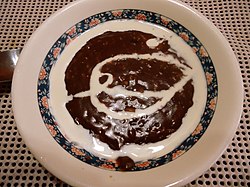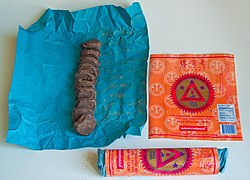  Top: A bowl of champorado with milk; Bottom: Tableya, locally made tablets of pure chocolate made from fermented, toasted, and ground cocoa beans Top: A bowl of champorado with milk; Bottom: Tableya, locally made tablets of pure chocolate made from fermented, toasted, and ground cocoa beans | |||||||
| Alternative names | Tsampurado | ||||||
|---|---|---|---|---|---|---|---|
| Type | Porridge | ||||||
| Place of origin | Philippines | ||||||
| Region or state | South East Asia | ||||||
| Serving temperature | Hot or cold | ||||||
| Main ingredients | Glutinous rice, tabliya, milk or coconut milk, sugar | ||||||
| Ingredients generally used | Daing or Tuyô and roasted cocoa beans | ||||||
| Variations | Tinughong | ||||||
| Food energy (per serving) | 244.30 kcal (1023 kJ) | ||||||
| Nutritional value (per serving) |
| ||||||
| Similar dishes | Champurrado | ||||||
Champorado or tsampurado (from Spanish: champurrado from champurrar 'to mix') is a sweet chocolate rice porridge in Philippine cuisine.
Ingredients
It is traditionally made by boiling sticky rice with tablea (traditional tablets of pure ground roasted cocoa beans). It can be served hot or cold, usually for breakfast or merienda, with a drizzle of milk (or coconut milk) and sugar to taste. It is usually eaten as is, but a common pairing is with salted dried fish (daing or tuyo).
Tinughong is a variant of champorado in the Visayan-speaking regions of the Philippines. It is usually made by boiling sticky rice with sugar instead of tablea. Coffee or milk are sometimes added to it.
A popular new variant of champorado is ube champorado, which has a purple yam (ube) flavoring and ube halaya. It is characteristically purple like all ube-based dishes. Other contemporary variants include white, pandan and strawberry flavors.
History
Its history can be traced back from the Spanish colonial period of the Philippines. During the galleon trade between Mexico and the Philippines, Mexican traders brought the knowledge of making champurrado to the Philippines (while tuba was introduced back in Mexico). Through the years, the recipe changed; Filipinos eventually found ways to make the Mexican champurrado a Philippine champorado by replacing masa with sticky rice.
See also
References
- ^ Almario, Virgilio, et al. 2010. UP Diksiyonaryong Filipino, 2nd ed. Anvil: Pasig.
- "champurrado". Diccionario de la lengua española. Royal Spanish Academy & Association of Academies of the Spanish Language. Retrieved December 16, 2024.
- Rose Catherine S. Tejano (December 16, 2012). "Sikwate Stories". The Bohol Chronicle (344). Archived from the original on August 13, 2016. Retrieved July 28, 2016.
- "Bisaya English Translation of "tinughong"". Cebuano Dictionary. Sandayong.com. Archived from the original on September 14, 2016. Retrieved July 28, 2016.
- "Ube Champorado". yummy.ph. October 18, 2017. Retrieved August 18, 2024.
- "Mexico Champorado". January 31, 2011. Retrieved May 8, 2018.
| Rice dishes | |||||||||||||
|---|---|---|---|---|---|---|---|---|---|---|---|---|---|
| North America |
| ||||||||||||
| South America | |||||||||||||
| Europe | |||||||||||||
| Africa | |||||||||||||
| West Asia | |||||||||||||
| Central Asia | |||||||||||||
| South Asia |
| ||||||||||||
| East Asia |
| ||||||||||||
| Southeast Asia |
| ||||||||||||
| Other | |||||||||||||
